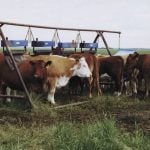Western Canadian feeder cattle prices were $2-$4 per hundredweight (cwt) lower on very thin summer volumes. Feeder cattle over 800 pounds were experiencing sharper losses, led by the weak U.S. market.
Barley prices in southern Alberta reached historical highs of $285 per tonne, and it appears that this feedgrain rally is not over. Adverse conditions are expected to continue in the Corn Belt, which will cause corn prices to stay firm or ratchet higher.
U.S. feeder cattle prices were down $4-$8/cwt as pasture conditions remain dry. It now looks like the herd liquidation will be similar to last year and fourth-quarter beef production will be larger than expected.
Read Also

U.S. livestock: Chicago cattle futures climb on post-Thanksgiving trade
Chicago | Reuters – Chicago Mercantile Exchange’s live and feeder cattle futures ticked up on Friday in a day of…
Alberta packers were buying cattle in the range of $110-$112/cwt, in line with a week earlier. Carcass weights are still 32 lbs. heavier than last year and with the higher feedgrain prices, buying enthusiasm for feeder cattle has waned.
In central Alberta, 500 to 600 steers traded in the range of $170-$180. There were no large group features to actually test the market. In the Calgary area, 800- to 900-lb. steers sold in the range of $125-$145/cwt. The U.S. Department of Agriculture reported that in Nebraska, steers weighing 882 lbs. sold for $138/cwt.
The USDA dropped its average corn yield estimate to 146 bushels per acre, down from their June estimate of 166 and down from the 2011 yield of 147.2. Many analysts are looking for further declines on upcoming reports and we could see the yield finish in the range of 135 to 140 bu./ac.
At this time, cattle producers need to factor in a worst case scenario as this rally in the feedgrain complex does not appear to be over just yet. I’m expecting more pressure on feeder cattle prices during the fall period due to stronger feedgrain prices.
— Jerry Klassen is a commodity market analyst in Winnipeg and maintains an interest in the family feedlot in southern Alberta. He writes an in-depth biweekly commentary, Canadian Feedlot and Cattle Market Analysis, for feedlot operators in Canada.














